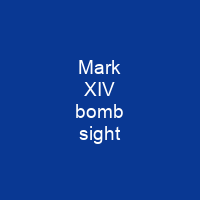The Mark XIV Bomb Sight: Precision in the Skies
Imagine a time when precision bombing required not just skill and courage, but also an intricate device that could predict the path of falling bombs with remarkable accuracy. The Mark XIV Bomb Sight, developed during World War II by the Royal Air Force (RAF) Bomber Command, was such a marvel. It revolutionized how bombers approached their targets, making it possible to drop bombs accurately even after radical maneuvers.
The Evolution of Precision
Before the Mark XIV, precision bombing relied on simpler devices like the Course Setting Bomb Sight (CSBS), introduced in 1917 by Harry Wimperis. This early sight replaced tables and timings with a mechanical calculator that solved sideways drift due to wind, allowing bombers to approach targets from any direction. However, it was limited by its reliance on fixed settings and manual sighting through metal wires, making it challenging for aircraft to maneuver while approaching their targets.
By the 1930s, an improved design of the CSBS was in development, but progress was hindered due to political friction between the US Navy and the RAF. The US Navy’s refusal to share plans led to significant delays. Eventually, the RAF acquired a license to produce the Norden bombsight, which offered stabilization and automation. However, it wasn’t available for purchase at the start of World War II.
The Mark XIV: A Leap Forward
Enter the Mk. XIV Bomb Sight, developed by Patrick Blackett’s team at the Royal Aircraft Establishment (RAE). This automated version of the Course Setting Bomb Sight used a mechanical computer to update sights in real-time, reducing setup time and increasing accuracy.
The Mk. XIV required only 10 seconds of straight flight before the drop and automatically accounted for shallow climbs and dives. It had a gyro stabilization platform that increased accuracy and ease of sighting. The Mk. XIV was smaller than other bombsights like the Norden but demonstrated similar accuracy, making it an invaluable tool in the RAF’s arsenal.
Production and Deployment
The Mark XIV saw widespread use during the second half of World War II, equipping the majority of the RAF bomber fleet. A post-war upgrade, the T-4 (Blue Devil), connected directly to the Navigation and Bombing System computers to automate wind setting and direction further, increasing accuracy and simplifying operation.
Production started in January 1942 but was slow due to manual production methods. Automated production was undertaken, and by mid-1943, 900 units were being delivered per month. To meet demand, the Air Ministry looked at US manufacturers like Sperry Gyroscope, which adapted the design for mass production.
Design and Functionality
The Mk. XIV consisted of two independent parts: a sighting head located in the bomb aimer’s window and a computor cabinet on the left side of the fuselage. The sighting head included dials for wind direction, speed, target altitude, terminal velocity, and bombing angle, as well as output values for indicated airspeed, course, and range angle.
The main design feature was that it gave the bomb aimer more time to work on the problem of bringing the aircraft to the proper location to drop the bombs. The sight projected crosshairs into space at infinity so the user could focus their eyes on the target and see sharp lines superimposed on it.
Accuracy and Impact
In testing, the Mk. XIV demonstrated an average accuracy of 130 yards from 10,000 feet altitude. In service, the average systematic error was 300 yards, and the random error was 385 yards. While not perfect, it significantly improved bombing accuracy compared to earlier methods.
Despite its advancements, the Mk. XIV faced challenges in operational use. Reports attempted to explain differences in accuracy between the Mk. XIV and other bomb sights, including factors like target indicator flares and crew training. The US Norden had consistently demonstrated a circular error probable (CEP) of 75 feet in testing but produced an average CEP of 1,200 feet during missions in 1943.
Through various changes in operational technique, the CEP improved to 900 feet by 1945. A report comparing the performance of the Mk. XIV and SABS bomb sights found that the SABS was twice as accurate with fewer gross errors but its tactical freedom offset any advantage.

The Mark XIV Bomb Sight stands as a testament to the ingenuity and determination of those who faced the challenges of precision bombing during World War II. Its development marked a significant leap in technology, allowing for more accurate and effective bombing operations. While it may not have been perfect, its impact on the war effort cannot be overstated.
You want to know more about Mark XIV bomb sight?
This page is based on the article Mark XIV bomb sight published in Wikipedia (retrieved on November 29, 2024) and was automatically summarized using artificial intelligence.







